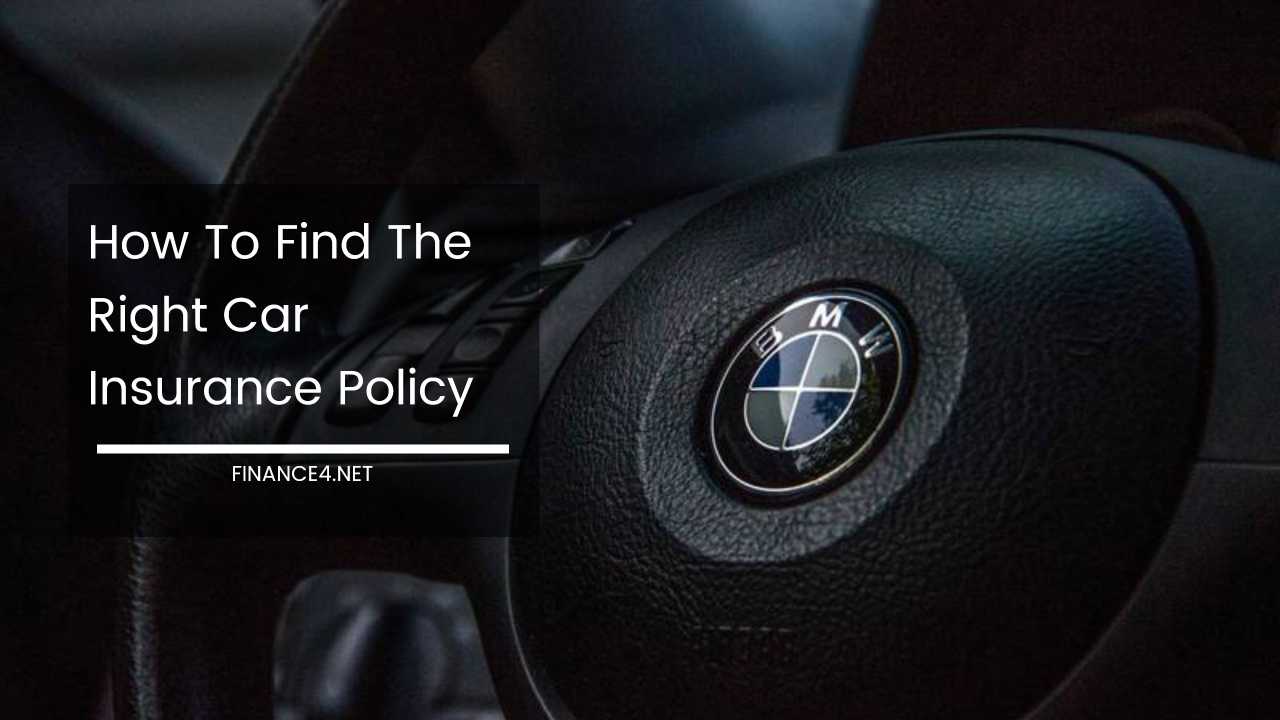How to Find the Right Car Insurance Policy

Demystifying the Maze of Car Insurance
Finding the right car insurance policy can feel like navigating a labyrinth. Faced with a sea of options and complex terminology, confusion often sets in. But fear not!
With some guidance and a clear understanding of your needs, preferences, and the available choices, you can transform this process into a smooth journey.
Choosing the right car insurance isn’t just about ticking a box; it’s about securing financial protection and peace of mind in the face of unexpected events on the road.
This comprehensive guide will equip you with the knowledge needed to make informed decisions and find the perfect car insurance policy.
Understanding Your Needs: The Foundation for a Secure Ride
Before delving into the intricacies of car insurance policies, take a step back and assess your specific needs and circumstances. Consider factors like:
- Driving Habits: How often do you drive? Where do you typically drive (city, highway, rural areas)? Do you use your car for commuting or leisure? These factors influence your risk profile and, consequently, your insurance premium. Younger drivers, those with long commutes, or those driving in high-traffic areas can expect higher premiums.
- Vehicle Type: The make, model, year, and value of your car significantly impact your insurance costs. Newer, more expensive cars with higher repair costs or a history of thefts generally require higher coverage levels compared to older, less valuable vehicles.
- Budgetary Constraints: Be realistic about how much you can comfortably afford to spend on car insurance premiums. Striking a balance between adequate coverage and affordability is key. Consider factors like your overall financial situation and risk tolerance.
- Desired Coverage Level: Do you prioritize comprehensive protection or basic liability coverage? Consider your risk tolerance and the potential financial implications of various scenarios. If you live in an area with high rates of theft or vandalism, comprehensive coverage might be essential.
Research and Compare: Unveiling the Best Deals
Once you have a clear understanding of your requirements, embark on a research expedition to explore different insurance providers and policies available in your area. Utilize online comparison tools and insurance company websites to gather quotes from multiple insurers. This allows you to compare:
- Coverage Options: Each policy offers a unique combination of coverages. Carefully analyze the inclusions and exclusions to ensure the policy aligns with your needs. Don’t be afraid to ask questions about specific coverages you might be unsure about.
- Deductibles: A deductible is the amount you pay out of pocket before your insurance kicks in. Higher deductibles translate to lower premiums, but require greater upfront financial responsibility in the event of a claim. Choose a deductible that you can comfortably afford in case of an accident.
- Premiums: The cost of your insurance policy. While cost is a significant factor, prioritize finding a policy that offers adequate coverage and excellent customer service. Don’t be tempted to compromise on protection for the sake of a slightly lower premium.
Types of Coverage: Understanding Your Options
Car insurance typically offers a variety of coverages, each serving a distinct purpose. Here’s a breakdown of the most common types:
- Liability Coverage (Mandatory in Most States): This acts as your safety net, covering damages and injuries you cause to others (people and property) in an accident. It usually comes in two parts:
- Bodily Injury Liability: Pays for medical expenses of those injured in an accident you cause.
- Property Damage Liability: Covers repairs or replacements for property damaged in an accident you cause (e.g., other vehicles, fences, buildings).
- Collision Coverage (Optional): This covers repairs to your own vehicle if it’s damaged in a collision with another object or vehicle, regardless of fault.
- Comprehensive Coverage (Optional): Protects your car against damages not caused by collisions, such as theft, vandalism, fire, weather events (e.g., hail, floods), or falling objects.
- Personal Injury Protection (PIP) or Medical Payments Coverage (Optional): This covers medical expenses for you and your passengers regardless of who is at fault in an accident. This can be particularly beneficial if you don’t have health insurance or your health insurance has limited coverage for auto accidents.
- Uninsured/Underinsured Motorist Coverage (Optional): Protects you financially if you’re involved in an accident with a driver who has no insurance or not enough insurance to cover the damages.
Customizing Your Policy: Tailoring Protection to Your Needs
Now that you understand the types of coverage available, it’s time to personalize your policy to precisely meet your specific needs. Consider these factors:
- Driving Habits: If you’re a low-mileage driver, you might qualify for lower premiums. Conversely, if you commute long distances or drive in high-traffic areas, your premiums may be higher. You can explore usage-based insurance options offered by some providers, which track your driving habits and reward safe drivers with lower premiums.
-
Vehicle Value: The value of your car directly impacts your coverage needs. Newer or more expensive vehicles might necessitate comprehensive coverage, whereas older vehicles might be adequately protected with basic liability coverage. Consider factors like your car loan situation. If you still owe a significant amount on your loan, comprehensive coverage might be required by your lender.
-
Additional Asset Protection: Do you want to safeguard other assets beyond your car? Some policies offer extended coverage options like roadside assistance, rental car reimbursement, or gap insurance.
- Roadside Assistance: This coverage provides help in case of unexpected breakdowns or emergencies on the road, such as flat tires, dead batteries, or lockouts.
- Rental Car Reimbursement: If your car is damaged in an accident and requires repairs, this coverage helps offset the cost of renting a car while yours is being fixed.
- Gap Insurance: This covers the difference between the actual cash value of your car (what your insurance company pays out in a total loss scenario) and the amount you still owe on your car loan. This can be beneficial if you have a newer car that depreciates quickly.
Beyond the Basics: Uncommon but Important Coverages
While the previously mentioned coverages are the most common, there are additional options available for specific situations:
- Medical Payments Coverage (For Passengers): This covers medical expenses for passengers in your car, regardless of who is at fault in an accident. This can be particularly useful if your passengers don’t have health insurance.
- Custom Parts and Equipment Coverage: If your car has valuable modifications or aftermarket parts, this coverage ensures they are protected in case of theft or damage.
- Towing and Labor Coverage: This covers the cost of towing your car to a repair shop in the event of a breakdown or accident.
Understanding Policy Wording and Fine Print
Once you’ve identified potential policies that align with your needs, take the time to thoroughly read and understand the policy wording and fine print. Here are some key aspects to pay attention to:
- Policy Limits: These represent the maximum amount your insurance company will pay out for a covered claim. There are typically separate limits for bodily injury, property damage, and comprehensive coverage. Choose policy limits that adequately cover potential costs associated with accidents or damages.
- Exclusions: These are situations or events not covered by your insurance policy. It’s crucial to understand these exclusions to avoid any surprises during a claim.
- Claims Process: Familiarize yourself with the process for filing a claim in case of an accident or damage. This includes understanding the steps involved, required documentation, and turnaround times for claim settlements.
The Power of Discounts: Lowering Your Premiums
While comprehensive coverage is essential, keeping your insurance costs manageable is important. Here are some ways to potentially lower your premiums:
- Maintain a Clean Driving Record: A history of accidents and traffic violations will significantly increase your premiums. Practice safe driving habits to maintain a clean record and qualify for discounts offered by many insurance companies.
- Take Advantage of Discounts: Many insurance providers offer various discounts. Explore options like good driver discounts, multi-car policy discounts (if you insure multiple vehicles), bundling your car insurance with your home insurance, taking defensive driving courses, or installing anti-theft devices in your car.
- Increase Your Deductible: As mentioned earlier, choosing a higher deductible lowers your premium. However, ensure you can comfortably afford the chosen deductible in case of a claim.
Finding the Right Insurance Provider: Beyond the Price Tag
While cost is a significant factor, consider these additional aspects when choosing an insurance provider:
- Financial Strength and Reputation: Research the financial stability and reputation of the insurance company. Opt for a company with a strong track record of claim settlements and customer service.
- Customer Service: Assess the quality of customer service offered by the insurance company. Consider factors like accessibility, responsiveness, and overall customer satisfaction ratings.
Final Thoughts: A Secure Ride with Informed Choices
Finding the right car insurance policy requires careful consideration, research, and understanding your unique needs.
By assessing your driving habits, vehicle value, and desired level of protection, you can tailor a policy that offers comprehensive coverage at an affordable price.
Remember to compare quotes from multiple insurers, explore discount options, and choose a reputable provider with excellent customer service.
Regularly review and update your policy as your circumstances change to ensure continuous protection. With the right approach, you can navigate the complexities of car insurance with confidence, knowing you’re well-prepared for any unexpected events on the road.



